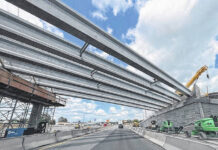
Motorists pass on Interstate 95 beneath the Exit 19 bridge on Carthage Road in Lumberton in this file photo. The bridge was demolished earlier this year and is being replaced as part of the improvements to the I-95 corridor. Construction on the project, which includes widening and raising portions of the highway, is expected to continue through Dec. 2026.
David Kennard | Robesonian file photo
Construction work to continue along I-95 through Dec. 2026
LUMBERTON — The stretch of Interstate 95 between Lumberton and Fayetteville can be claustrophobic at times with concrete barrier walls placed along the sides of the road coupled with the jarring 18-wheelers that rumble through the steady traffic.
The entire corridor under construction in this part of the state encompasses 28 miles, from mile marker 13 to mile marker 41. There exists a 12-mile gap from that portion of the highway before more construction work continues between mile marker 56 and 81 at the Dunn work zone.
Stacks of cut trees, limbs, shrubs — some in the process of being burned — are a common sight along the route, with smoke wafting into the highway from the occasional one.
Joe Bailey is a project engineer for the Raleigh office of the North Carolina Department of Transportation; the state contracted his firm, KCI Technologies of Sparks, Maryland, to complete construction work on an eight-mile section — from mile marker exit 13 to mile marker 21 — that covers most of the city of Lumberton.
The entire 28-mile corridor — which is being funded through a series of contracts — is being widened. At completion, the interstate will be enlarged to eight lanes from mile marker 13 to mile marker 40 and then six lanes from mile marker 40 to 41.
Including the Dunn expansion projects, which stretch from mile marker 56 to 81, the entire slab of interstate construction runs for a total of 54 miles.
The estimated cost of Bailey’s project alone in the Lumberton area is $437 million, he said.
“I am specifically assigned to this one project,” he said Friday by phone. “Our contract not only calls for the construction of the project but also we look after the design, obtain the right of way, handle utility relocations and then build it.”
Currently, Bailey said, the work in the city includes a lot of water line installation, relocating the water line, and installing temporary and permanent drainage.
As far as upcoming changes, he said, “You’re going to see at exit 20 (Roberts Avenue) — we’re going to start in the next couple of weeks to do some revisions at that location. Once that is done, the southbound ramp from (N.C.) 211 to southbound (I-)95 — that ramp will be closed and traffic will utilize the loop to get on now.
“That’s one item coming up in the near future that people will see,” he added.
Right now, Bailey said, “the main emphasis we have other than utility relocation and right-of-way acquisition is widening the southbound side for a temporary widening so eventually we put all the traffic on the southbound side and then build the northbound side in its entirety.”
That includes changing the grade in some areas due to past severe flooding from Hurricanes Floyd and Matthew.
“Why is the overall widening? Just to meet current and future travel needs,” he said. “The capacity for I-95 is, I believe, the second-highest volume of traffic on I-95 is here in Lumberton. By design standards, it warrants more than the four lanes that are here. We’re also doing a lot, hopefully, to alleviate flooding, at least from the roadway.”
The daily average during weekdays along the Lumberton section is about 70,000 vehicles that pass through, Bailey said. During weekends and in the peak summertime, that daily average significantly increases 15% to 20% — to near 100,000 cars a day.
According to Bailey, the state also is significantly raising exits 17 and 20 about five feet and raising exit 19 to roughly 13 feet.
“Those are very significant grade changes,” he said. “All those areas that have been flooded in the past are being raised significantly.”
A related project to construct a floodgate under the highway near VFW Road in Lumberton is in the planning stages; this will also help to alleviate flooding concerns in the area, located near the Lumber River and Luther Britt Park.
The roadwork, which got underway with temporary widening in the spring, is scheduled to be completed in December 2026.
As for those intimidating concrete barrier walls that motorists pass by with white knuckles, Bailey said, “they will be there for the duration of the project. As we do different phases, we move them around. Without those, we have to close lanes, that way to protect workers from the traveling public. So we put those in there so we can work behind those and not have to close the lane.
“Because the impact of closing lanes is — you know — nobody likes to have lane closures,” he said. “And we also limit lane closures to nighttime. By having barrier walls there, it allows work during the day which is more productive.”
Reach Michael Futch by email at [email protected].








